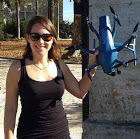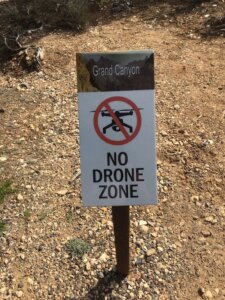 Robotics and drone technologies are one of the fastest growing end-use markets for integrated sensor technology today. According to a 2016 Yole Développement market report, the 2015 $351M US sensor market for drones and robots is expected to double by 2021, reaching US$ 709 million at a 12.4% CAGR. Key technologies include 3D cameras, solid state light detection and ranging (LIDAR), and ultra-precise gyroscopes. To better understand the sensor and semiconductor device requirements of these products, 3D InCites spoke with Eva Pagneux, VP of strategy and marketing at Squadrone System, a Grenoble-based manufacturer of smart, self-flying devices for indoor and outdoor consumer and industrial applications.
Robotics and drone technologies are one of the fastest growing end-use markets for integrated sensor technology today. According to a 2016 Yole Développement market report, the 2015 $351M US sensor market for drones and robots is expected to double by 2021, reaching US$ 709 million at a 12.4% CAGR. Key technologies include 3D cameras, solid state light detection and ranging (LIDAR), and ultra-precise gyroscopes. To better understand the sensor and semiconductor device requirements of these products, 3D InCites spoke with Eva Pagneux, VP of strategy and marketing at Squadrone System, a Grenoble-based manufacturer of smart, self-flying devices for indoor and outdoor consumer and industrial applications.
The Back Story
Squadrone System is a Kickstarter success story born of the inspiration and ingenuity of co-founder, Xavier De Le Rue, three-time world championship snowboarder, who wanted a way to film his adventures without hiring a crew to follow him around. Working with a team that combined expertise in adventure filming, aeronautics, and embedded flight control, he designed the company’s flagship consumer product, Hexo +, a completely autonomous drone that follows users and films adventures from above. This video follows beta testers in Lake Tahoe, who tried out the Hexo +. See what they have to say about it:
To launch the company and bring Hexo+ to market, De Le Rue and his co-founders, including current CEO Antoine Level, launched a Kickstarter campaign, raising more than $1.3M within a month. Within a year, Squadrone System went from concept to reality, delivering more than 3000 units to users across the world. The company’s background is in critical embedded systems for civil aviation, computer vision and data fusion. They serve consumer and industrial applications targeting logistics, insurance, and defense.

Formerly the global marketing communications manager at Movea, provider of data fusion and motion processing products, Pagneux’ joined Squadrone as VP of Marketing after learning about the company from a former Movea colleague.
“I’ve always been interested in how technology can change the life of people for the better, specifically intelligent and connected objects,” she said. Her position at Squadrone allows her to leverage a background in business and innovation management to lead initiatives that bring internationally recognized innovative products to consumers: from defining the bike of the future to motion-enabled smartTV remote control, context-aware smartphones and now completely autonomous drones.
The Drone Evolution
Pagneux says it’s an interesting time for the drone industry. The commercial sector is flourishing, with new drone uses being discovered every day that creates value for businesses. For example, Amazon has introduced drones into logistics applications, using them in their warehouses to sort items, as well as launching a drone delivery system. Walmart has also announced they’d be working with drones. “Having a giant like Walmart get involved has helped us get into the commercial segment,” she said.
Additionally, Pagneux says there’s been an increase of inter-industry acquisitions and alliances among key players who believe in the power of drones to enable processes of tomorrow. For example, Intel has invested in several drone technologies.

However, there are still hurdles to drone mass adoption. Regulations play a key role. While the FAA is making it easier to use drones for professional purposes, drone flight is limited in certain areas under certain conditions (Figure 2).
It is important to make drones accessible as more people realize what they can do for them. For example, an easy-to-use interface that is controlled through tablets, such as an iPad, is an improvement over the old clunky remote control. “Drones with propeller guards and simple set up systems make them approachable and usable,” explained Pagneux “Obviously if it requires extensive training and time to use a drone, the benefits might not be as big.”
She added that system robustness is a critical element because if devices fail, people will be afraid to use them, governments will not trust them, and regulations will not evolve. By providing the assurance of reliable systems, industry players enable sustainable growth.
Technology Drivers
The drone industry is fast-paced and exciting, with new capabilities being released every month, said Pagneux. So naturally, key technologies are those that make drones smarter, so they require less human interaction and can grow from remote sensing devices/robots to automated intelligent robots capable of making decisions that accelerate business processes and generate more value.
She identified three main capabilities for next-generation drones.
- Obstacle avoidance
- Artificial intelligence
- flight intelligence/ context awareness
The Role of Sensors
The drone industry is eager for sensors that not only make drones smarter but also enable more activities, noted Pagneux. Squadrone System’s drones contain a 9-axis inertial motion unit (IMU), as well as pressure sensors, a vision camera, and GPS.
The IMU allows for the drones to fly steadily and know where it is going. Without those sensors, a drone can quickly become very dangerous, flying to places out of the user’s control.
Pressure sensors allow us to detect the altitude. For example, with Hexo+, users fly the drone in the mountain going up and down at 45mph on a bike. If the drone doesn’t follow the altitude of the rider, there’s a likely chance that the drone will run into the first hill ahead.
The camera allows the drone to record the fun times, scan a barcode, or take pictures of a damaged zone.
The GPS allows the drone to know where it is. GPS accuracy is very important to ensure the drone flies only where the user intends to avoid crashes. As such, pre-flight checks are set that require a certain accuracy for take-off, thereby ensuring a safe flight.
“Ensuring a safe flight is basic for drone adoption,” noted Pagneux. “As such, we’ve spent a great deal of time on these topics, selecting the right sensors to meet our expectations.”
Pagneux sees opportunities for additional sensors such as thermal imaging for identifying leaks or living organisms, LIDAR for avoiding obstacles, a multispectral camera would allow healthier agriculture, and gas and temperature sensors allow for remote observation of the quality of the environment in spots that were not able to be measured.
The Role of Semiconductor Devices
When it comes to semiconductor device requirements, Pagneux says drones are full of trade-offs related to weight and size. The smaller the components are, the more integrated and intelligent they are, the better suited they are for drones because everything needs to happen from a tiny device in the air. Today’s challenge is optimizing space on the drone while having enough processing power to enable intelligent activities, processing images and information in real time so decisions can be made.
“The advancements in semiconductor technologies are of very much interest for us,” she said. “That’s also why Intel, Qualcomm or Nvidia are all betting on drones, they’re aware it’s a $17B industry by 2022 and they want to be part of it!”
When deciding to implement a technology, Pagneux says both cost and performance are important but differ depending on the end market. “When building a consumer product, there are selling price expectations that cannot be pushed, and so we require the best sensors that fit our tight bill of materials. As long as we can ensure safety and reliability, we’re happy.” She explained. “Quality expectations are higher for professional applications as they require more sensors and applications. However, these customers are willing to spend more to have a device that can go into remote places and save thousands of dollars.”
What’s Next for Drones
Today’s consumer and commercial drones are mostly used to take images. The goal for future drone generations is to make them smarter and context aware. Drones that are capable of navigating by themselves, can sense more things, and make decisions will be more like flying robots. This relies on increased processing power and artificial intelligence. As such, the drone industry is relying on the semiconductor industry to continue innovating at a more rapid pace to keep up with this rapidly evolving market.



















